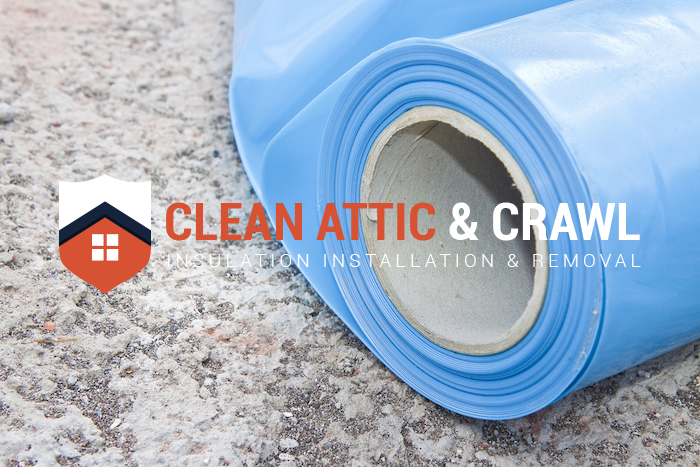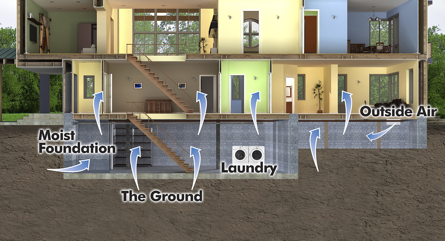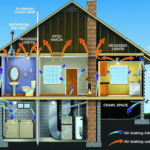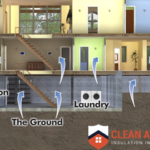Damp Proofing With Vapor Barriers
What is a Vapor Barrier?
A vapor barrier is a foil or plastic sheet that’s utilized for damp proofing. It’s specially designed to prevent transmission of moisture along the floor, wall, roof, or ceiling conventions of structures to restrain interstitial condensation.

Many of the available vapor barriers are vapor retarders which come with different permeability degrees. Many people may not tell the difference between air barriers and vapor barriers. This is attributed to the fact that air details high quantities of moisture in the form of vapor.
When this air changes locations due to air pressure variance, the vapor transitions with it in a process described as, the water vapor migration. Air barriers can also be described as vapor barriers especially when they regulate the transfer of moisture charged air. Vapor barriers also result from cold climate components which spread into other climates. The factors behind vapor barriers resulting from cold climate are attributed to personalities compared to physics.
According to Rose (1997) regales readers of this history theory, the fact that development practices can be determined by minimal research can be astounding.
Does a Crawl Space need a Vapor Barrier?
The crawl space is a damp and dark that can be reproduction ground for mildew, and mold if ultimate care is not exercised. You can prevent this health hazard by adopting a crawl space vapor barrier in cases where your floor often gets dirty. Various companies specialize in installing top quality crawl spaces complete with foam insulation for many years now. The process involves wrapping the crawl space walls by use of plastic across the dirty floor which often blocks vapor.

Why is the use of vapor barriers in crawl spaces becoming so popular? You can only understand this by knowing what a crawl space vapor barrier is. Perhaps you are one of the people who can’t understand the importance of a crawl space vapor barrier on dirt floors. This is often attributed to science and nature. If moisture soaks in your crawl space, it can result in numerous problems.
It’s worth noting that moisture can emanate from the soil up into your crawl space. Many people opine that moisture only comes from a leak which is not the case. This moisture causes the growth of mildew and mold which can cause major health complications. Further, if your crawl space features fiberglass with no vapor barrier, you can be assured that moisture will be retained in your crawl space.
This not only damages your home but it can also cause rust metal and rotting of wood. If you don’t have a vapor barrier the moisture that penetrates your crawl space from the soil can cause electric shorts hence jeopardizing you and your family. Excess moisture up your crawl space can be the reason your plumbing system is rusting and breaking down frequently.
What is the Best Vapor Barrier for Crawl Space?
Many experts recommend an augmented plastic polyethylene sheeting measuring 6 mil in thickness as the ultimate material for use as a vapor barrier. The liner provides a level of durability and value even though it’s the least vapor barrier thickness. Augmented plastic polyethylene sheeting comes in various strengths and thicknesses.
If you are going to purchase this material at your nearest store, you may want to consider its thickness, since local stores often stock non augmented and thinner materials often made from recycled polyethylene. Remember, recycled polyethylene may have impurities such as moisture and dirt.
Further, this material is not designed for long term use. If you are looking for durable materials for prolonged use, ensure to purchase augmented material such as crawl space vapor barriers. Appropriately installed augmented material is designed to last up to 20 or more years in your crawlspace.
Crawl Vapor Barrier Thickness to Consider
When shopping for the ideal crawl space vapor barrier, you need to understand the perms and mils measurements. The former defines moisture permeability while the latter defines the thickness of your preferred material.
Perms
The perm rating refers to the ease with which water vapor penetrates across a material. When a material has a low perm rating, it means that the material is less permeable. In order to be categorized as a vapor barrier, a material should come with a 0.1 perm rating or below. A polyethylene sheeting material whose thickness is 6 mils is ideal in this case.
Mils
Polyethylene sheeting material is measured in mils. 1 mil is equivalent to 0.001-inch thickness. The common recommendation in many residential applications is a 0.006-inch thickness or 6 mil augmented polyethylene vapor barrier. There are various other manufacturers whose polyethylene sheeting materials measure 20 mil.
How to Choose the Ideal Crawl Space Vapor Barrier
Two factors determine the polyethylene sheeting material thickness you choose. They are:
- Material or soil on the crawl space floor
- Use of the crawl space.
Do you plan to convert your crawl space into a storage area for your extra items? Or do you anticipate a case where you’ll access the crawl space often for maintenance purposes? If the answer to any of these questions is yes, then you may want to purchase a thicker polyethylene sheeting material. For instance, the best material should be approximately 12 mil.
A 6 mil polyethylene may not be perfect for such a setting or even a crawl space that has roots, rocks, or concrete blocks. It’s worth noting that even a single puncture or tear in the vapor barrier will let in moisture which makes it ineffective. You can, however, save costs without necessarily compromising on durability by using a thinner polyethylene such as an 8 mil or 6 mil on your crawl space walls and choose a thicker polyethylene for your floor.
Should I put Plastic in my Crawl Space?
Plastic sheeting material plays various roles in your crawl space. Usually, plastic material is utilized in residential crawl spaces to prevent vapor or moisture. This helps reduce the risk of mildew or mold formation in your home. It also provides extra storage space in your home. Choosing the ideal plastic sheeting and installing it appropriately helps you enjoy both functionality and value for your money.
What do you need to Install Plastic in Your Crawl Space?
You’ll need various materials which include: a tape measure, a straightedge, a hammer, landscape fabric stakes, duct tape, and a utility knife. Remember, soil variance and regional climate can necessitate the use of more materials and the use of various approaches. Still, polyethylene plastic sheeting material is ideal for safeguarding storage areas as well and preventing moisture generation in the home.
Always choose a thicker material because thin materials are susceptible to damage during the installation process such as augmenting supports and concrete pouring. These can poke holes in the plastic, which then allows in moisture and in the end making the entire process ineffective.
As mentioned before, you can opt for a 10 mil or 20 mil plastic sheeting material if you are looking for the ultimate reinforcement, value for money, moisture resistance, and durability. Measure the width and length of your crawl space prior to purchasing the sheeting material. You will need sufficient plastic sheeting material ranging from 6 to 30 inches.
Installing the Plastic Sheeting
Assemble your sheeting materials and start cutting and start trimming and laying your plastic strips down across the unsecured soil area within your crawl space. Ensure seams in between your plastic sheets intersect and then use a tape to fasten them.
Utilize the landscape fabric stakes and drive them down through the soil throughout the edges to fix the sheeting material to the soil. Further, leave a few inches of sheeting allowance along with your crawl space edges where the soil and the walls converge. Cover masonry foundation walls with drywall or moisture proof insulation.
How Much Does it Cost to Install a Vapor Barrier in a Crawl Space
On top of installing your polyethylene sheeting material on your crawl space, some contractors opine that creating an air barrier is a good idea. For instance, open spray cell foam can be sprayed along the walls once the vapor barrier has been installed. This method is ideal because approximately 98% of water vapor transfer penetrates in your home via the movement of air.
The air barrier, therefore, regulates the moisture content inside your home. According to the Energy Department, air sealing gaps must be adopted in the home for appropriate moisture regulation.
Crawl Space Vapor Barrier Cost
Various factors affect the installation of a vapor barrier in your home. First, you should establish whether you will hire a contractor to lay the sheeting plastic or are skilled enough to do it on your own. Further, will you include insulation?
If you are qualified enough to execute the task, the cost depending on the existing prices at home enhancement stores would be approximately $640 for a 1,500 sq ft home. Still, this is exclusive of the cost of additional materials you may need such as gloves, utility knife, and tape.
If you plan to hire a contractor instead, the cost could go up by between two or even three times the cost of doing it yourself. Still, you may need to use the services of an experienced contractor if you want to include insulation. Then they can install both the vapor barrier and the insulation appropriately.
Finally
In order to effectively prevent moisture in your crawl space, you can begin by installing the vapor barrier. However, it’s worth mentioning that insulation plays a huge role in eliminating the problem.


